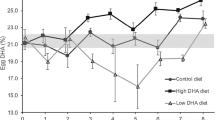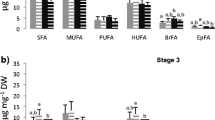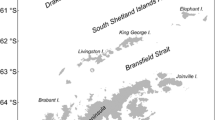Abstract
A suite of characteristics is often used to assess egg quality as these properties potentially play important roles in progeny survival and growth. Our objective was to assess egg characteristics including lipid biocomposition of an iteroparous, batch-spawning teleost of wild origin. Maternal allocation to egg number was generally dome-shaped (5 of 8 females) and egg size declined over the breeding season for eight breeding pairs of wild Atlantic cod (Gadus morhua) (n = 43 batches). Egg lipid composition ranged considerably among females and between egg batches within females (e.g., phospholipids 40–86 %; polar 47–87 % and neutral lipids 15–52 % of total lipids; polyunsaturated fatty acids 16–50 % of total fatty acids). Principal component analyses revealed significant inter-relationships among maternal traits, batch sequence and fecundity, and egg size and composition. Seasonal trends with regard to lipid deposition were variable; three females showed consistent declines in lipid parameters (μg egg−1) with both batch number and egg diameter, one female showed consistent increase and the four remaining females showed no trend. The three females that exhibited seasonal declines in egg lipid content were characterized as having high fertilization success (>75 %). Our findings highlight the variability in lipid allocation to eggs of batch spawners of wild origin and characterize the composition of endogenous reserves available during embryogenesis and yolk sac larval stages.








Similar content being viewed by others
References
Almansa E, Pérez MJ, Cejas JR, Badía P, Villamandos JE, Lorenzo A (1999) Influence of broodstock gilthead seabream Sparus aurata L. dietary fatty acids on egg quality and egg fatty acid composition throughout the spawning season. Aquaculture 170:323–336
Bachan MM (2011) Maternal influences on egg quality and larval morphology, survival and growth of the batch-spawning Atlantic cod (Gadus morhua). Master’s thesis, Memorial University of Newfoundland
Benjamini Y, Hochberg Y (1995) Controlling the false discovery rate: a practical and powerful approach to multiple testing. J Roy Stat Soc B 57(1):289–300
Bransden MP, Battaglene SC, Goldsmid RM, Dunstan GA, Nichols PD (2007) Broodstock condition, egg morphology and lipid content and composition during the spawning season of captive striped trumpeter, Latris lineata. Aquaculture 268:2–12
Brooks S, Tyler CR, Sumpter JP (1997) Egg quality in fish: what makes a good egg? Rev Fish Biol Fisher 7:387–416
Budge SM, Iverson SJ, Bowen WD, Ackman RG (2002) Among- and within-species variability in fatty acid signatures of marine fish and invertebrates on the Scotian Shelf, Georges Bank, and southern Gulf of St. Lawrence. Can J Fish Aquat Sci 59:886–889
Chambers RC, Leggett WC (1996) Maternal influences on variation in egg sizes in temperate marine fishes. Am Zool 36(2):180–196
Chambers RC, Waiwood KG (1996) Maternal and seasonal differences in egg sizes and spawning characteristics of captive Atlantic cod, Gadus morhua. Can J Fish Aquat Sci 53:1986–2003
Clark MJR (2008) Lipids, fatty acids and free amino acids as indicators of egg and larval viability in Atlantic cod (Gadus morhua). Master’s thesis, Memorial University of Newfoundland
Cushing DH (1990) Plankton production and year-class strength in fish populations: an update of the match/mismatch hypothesis. Adv Mar Biol 26:249–293
Czesny S, Rinchard J, Dabrowski K (2005) Intrapopulation variation in egg lipid and fatty acid composition and embryo viability in a naturally spawning walleye population from an inland reservoir. N Am J Fish Manag 25:122–129
Daniel ES, Parrish CC, Somerton DC, Brown JA (1993) Lipids in eggs from first-time and repeat spawning Atlantic halibut, Hippoglossus hippoglossus (L.). Aquacult Fish Manag 24:187–191
Dean RB, Dixon WJ (1951) Simplified statistics for small numbers of observations. Anal Chem 23:636–638
Devauchelle N, Coves D (1988) The characteristics of sea bass (Dicentrarchus labrax) eggs: description, biochemical composition and hatching performances. Aquat Living Resour 1:223–230
Evans RP, Parrish CC, Brown JA, Davis PJ (1996) Biochemical composition of eggs from repeat and first time spawning captive Atlantic halibut (Hippoglossus hippoglossus). Aquaculture 139:139–149
Finn RN, Fyhn HJ, Evjen MS (1995) Physiological energetics of developing embryos and yolk-sac larvae of Atlantic cod (Gadus morhua). I. Respiration and nitrogen metabolism. Mar Biol 124:355–369
Folch J, Lees M, Stanley GHS (1957) A simple method for the isolation and purification of total lipids from animal tissues. J Biol Chem 226:497–509
Fordham SE, Trippel EA (1999) Feeding behaviour of cod (Gadus morhua) in relation to spawning. J Appl Ichthyol 15:1–9
Fraser AJ, Gamble JC, Sargent JR (1988) Changes in lipid content, lipid class composition and fatty acid composition of developing eggs and unfed larvae of cod (Gadus morhua). Mar Biol 99:307–313
Hislop JRG, Bell MA (1987) Observations on the size, dry weight and energy content of the eggs of some demersal fish species from British marine waters. J Fish Biol 31:1–20
Kaitaranta JK, Ackman RG (1981) Total lipids and lipid classes of fish roe. Comp Biochem Physiol B 69:725–729
Kjesbu OS (1989) The spawning activity of cod, Gadus morhua L. J Fish Biol 34:195–206
Kjesbu OS, Witthames PR, Solemdal P, Greer Walker M (1990) Ovulatory rhythm and a method to determine the stage of spawning in Atlantic cod Gadus morhua. Can J Fish Aquat Sci 47:1185–1193
Kjesbu OS, Klungsoyr J, Kryvi H, Witthames PR, Greer Walker M (1991) Fecundity, artesia, and egg size of captive Atlantic cod (Gadus morhua) in relation to proximate body composition. Can J Fish Aquat Sci 48:2333–2343
Kjesbu OS, Solemdal P, Bratland P, Fonn M (1996) Variation in annual egg production in individual captive Atlantic cod (Gadus morhua). Can J Fish Aquat Sci 53:610–620
Kjørsvik E, Mangor-Jensen A, Holmefjord I (1990) Egg quality in fishes. Adv Mar Biol 26:71–113
Lambert Y, Thorsen A (2003) Integration of captive and wild studies to estimate egg and larval production of fish stocks. J Northw Atl Fish Sci 33:71–79
Lanes CFC, Bizuayehu TT, Bolla S, Martins C, de Oliveira Fernandes JM, Bianchini A, Kiron V, Babiak I (2012) Biochemical composition and performance of Atlantic cod (Gadus morhua L.) eggs and larvae obtained from farmed and wild broodstocks. Aquaculture 324–325:267–275
Lavens P, Lebegue E, Jaunet H, Brunel A, Dhert Ph, Sorgeloos P (1999) Effect of dietary essential fatty acids and vitamins on egg quality in turbot broodstocks. Aquacult Int 7:225–240
Markle DF, Waiwood KW (1985) Fertilization failure in gadids: aspects of its measurements. J Northw Atl Fish Sci 6:89–93
Martin-Robichaud DJ, Rommens MA, Vallee L (1998) Sex determination of flatfish and gadids using ultrasonography. Bull Aquacult Assoc Can 98(3):19–23
Mazorra C, Bruce M, Bell JG, Davie A, Alorend E, Jordan N, Rees J, Papanikos N, Porter M, Bromage N (2003) Dietary lipid enhancement of broodstock reproductive performance and egg and larval quality in Atlantic halibut (Hippoglossus hippoglossus). Aquaculture 227:21–33
Murua H, Saborido-Rey F (2003) Female reproductive strategies of marine fish species of the North Atlantic. J Northw Atl Fish Sci 33:23–31
Ouellet P, Lambert Y, Bérubé I (2001) Cod egg characteristics and viability in relation to low temperature and maternal nutritional condition. ICES J Mar Sci 58:672–686
Parrish CC (1999) Determination of total lipid, lipid classes, and fatty acids in aquatic samples. In: Arts MT, Wainman BC (eds) Lipids in freshwater ecosystems. Springer, New York, pp 4–20
Parrish CC, Wells JS, Yang Z, Dabinett P (1999) Growth and lipid composition of scallop juveniles, Placopecten magellanicus, fed the flagellate Isochrysis galbana with varying lipid composition and the diatom Chaetoceros muelleri. Mar Biol 133:461–471
Penney RW, Lush PL, Wade J, Brown JA, Parrish CC, Burton MPM (2006) Comparative utility of egg blastomere morphology and lipid biochemistry for prediction of hatching success in Atlantic cod, Gadus morhua L. Aquacult Res 37:272–283
Pickova J, Dutta PC, Larsson P-O, Kiessling A (1997) Early embryonic cleavage pattern, hatching success, and egg-lipid fatty acid composition: comparison between two cod (Gadus morhua) stocks. Can J Fish Aquat Sci 54(10):2410–2416
Rainuzzo JR, Reitan KI, Olsen Y (1997) The significance of lipids at early stages of marine fish: a review. Aquaculture 155:103–115
Rideout RM, Trippel EA, Litvak MK (2005) Effects of egg size, food supply and spawning time on early life history success of haddock Melanogrammus aeglefinus. Mar Ecol Prog Ser 285:169–180
Saborido-Rey F, Kjesbu OS, Thorsen A (2003) Buoyancy of Atlantic cod larvae in relation to developmental stages and maternal influences. J Plankton Res 25:291–307
Salze G, Tocher DR, Roy WJ, Robertson DA (2005) Egg quality determinants in cod (Gadus morhua L.): egg performance and lipids in eggs from farmed and wild broodstock. Aquacult Res 36:1488–1499
Sargent JR (1995) Origins and functions of egg lipids: nutritional implications. In: Bromage NR, Roberts RJ (eds) Broodstock management and egg and larval quality. University Press, Cambridge, pp 353–372
Sargent JR, Tocher DR, Bell JG (2002) The lipids. In: Halver JE, Wardy RW (eds) Fish nutrition, 3rd edn. Academic Press, London, pp 182–257
Sawanboonchun J, WJ Robertson, DA Robertson, Bell JG (2008) The impact of dietary supplementation with astaxanthin on egg quality of Atlantic cod broodstock (Gadus morhua L.). Aquaculture 283:97–101
Sinclair M, Tremblay MJ (1984) Timing of spawning of Atlantic herring populations (Clupea harengus harengus) and the match-mismatch theory. Can J Fish Aquat Sci 41:1055–1065
Thorsen A, Trippel EA, Lambert Y (2003) Experimental methods to monitor the production and quality of eggs of captive marine fish. J Northw Atl Fish Sci 33:55–70
Tocher DR, Sargent JR (1984) Analyses of lipids and fatty acids in ripe roes of some northwest European marine fish. Lipids 19(7):492–499
Trippel EA (1998) Egg size and viability and seasonal offspring production of young Atlantic cod. Trans Am Fish Soc 127:339–369
Trippel EA, Neil SRE (2004) Maternal and seasonal differences in egg sizes and spawning activity of northwest Atlantic haddock (Melanogrammus aeglefinus) in relation to body size and condition. Can J Fish Aquat Sci 61:2097–2110
Trippel EA, Kraus G, Köster FW (2005) Maternal and paternal influences on early life history traits and processes of Baltic cod Gadus morhua. Mar Ecol Prog Ser 303:259–267
Tveiten H, Jobling M, Andreassen I (2004) Influence of egg lipids and fatty acids on egg viability, and their utilization during embryonic development of spotted wolf-fish, Anarhichas minor Olafsen. Aquacult Res 35:152–161
Ulvund KA, Grahl-Nielsen O (1988) Fatty acid composition in eggs of Atlantic cod (Gadus morhua). Can J Fish Aquat Sci 45:898–901
Verhoeven KJF, Simonsen KL, McIntyre LM (2005) Implementing false discovery rate control: increasing your power. Oikos 108:643–647
Wiegand MD (1996) Composition, accumulation and utilization of yolk lipids in teleost fish. Rev Fish Biol Fish 6:259–286
Wright PW, Trippel EA (2009) Fishery-induced demographic changes in the timing of spawning: consequences to reproductive success. Fish Fish 10:283–304
Yanes-Roca C, Rhody N, Nystrom M, Main KL (2009) Effects of fatty acid composition and spawning season patterns on egg quality and larval survival in common snook (Centropomus undecimalis). Aquaculture 287:335–340
Zhu P, Parrish CC, Brown JA (2003) Lipid and amino acid metabolism during early development of Atlantic halibut (Hippoglossus hippoglossus). Aquacult Int 11:43–52
Acknowledgments
Financial support for this study was provided by the Fisheries and Oceans Canada ACRDP Program (EAT) and an NSERC Discovery grant (IAF). Thanks to the staff at St. Andrews Biological Station, particularly by Steve Neil, John Reid, Ken Howes, and Marc Blanchard, your help was greatly appreciated. Extra special thanks to Pierre Pepin, Chris Parrish, and Rick Rideout for their valuable suggestions and input, Jeanette Wells and Marsha Clarke for technical support, guidance and assistance in the Parrish lab at the Ocean Sciences Centre and Danny Ings for statistical assistance. Comments made by anonymous referees toward improving the manuscript were greatly appreciated.
Author information
Authors and Affiliations
Corresponding author
Additional information
Communicated by M. A. Peck.
Electronic supplementary material
Below is the link to the electronic supplementary material.
Rights and permissions
About this article
Cite this article
Bachan, M.M., Fleming, I.A. & Trippel, E.A. Maternal allocation of lipid classes and fatty acids with seasonal egg production in Atlantic cod (Gadus morhua) of wild origin. Mar Biol 159, 2281–2297 (2012). https://doi.org/10.1007/s00227-012-2014-6
Received:
Accepted:
Published:
Issue Date:
DOI: https://doi.org/10.1007/s00227-012-2014-6




